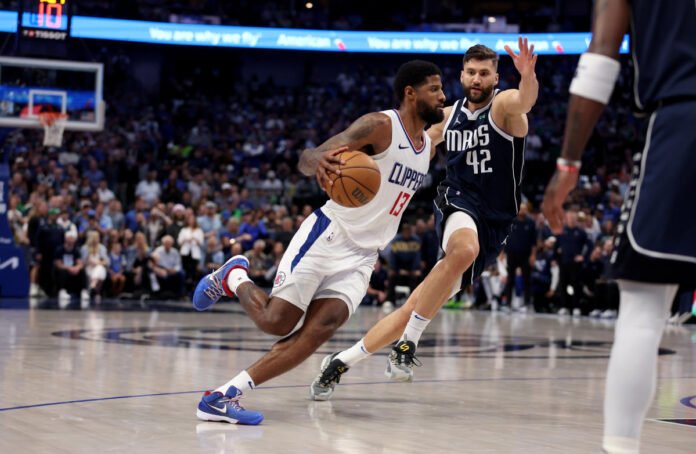LAS VEGAS — Money underlines NBA Summer League. Money underlines the NBA, really, the true green code of this 30-team Matrix — from the restrictions of the league’s collective bargaining agreement to the spending power of NIL collectives possibly keeping talent from the league. This week, this annual gathering when everyone from All-Stars to general managers to the college world’s most connected flock to the dry heat of this desert, that code blinks and flickers from the Thomas & Mack center to the hallways of the Wynn. Which swankiest hotel of the swankiest hotel does your team stay at? What lavish dinner, charged to some company card, are you attending? Look who’s holding court at the $100 tables.
The fact business is still being conducted here — veteran minimum signings, completed rookie contracts, dismissed coaches and front office staffers searching for their next gigs — underscores every event, every catch-up conversation at the top of the Cox Pavilion stands. This summer, the first offseason governed by rules of the league’s new second-apron CBA, has brought plenty of chatter among NBA personnel around Summer League about a relatively quick and quiet free agency and what looks to be the early shaping of a new era of the league’s business.
The harsher penalties and limitations that come when a team’s total cap sheet surpasses the second apron, an additional luxury tax line beginning with this 2024-25 campaign — $188.931 million for 2024-25 compared to a first apron of $178.132 million — were the Clippers’ main reasons for not competing with Philadelphia’s offer for Paul George. While fans of the Miami Heat, the Milwaukee Bucks and the Denver Nuggets have shared frustration about their all-in, supposed-to-be contending teams’ lack of significant movement this summer, there are simply limited opportunities for the Bucks, who are already locked into the second apron, while Denver is hard-capped at the second apron and Miami is tip-toeing that line by $1.6 million.
There isn’t much of a free-agency landscape to work through, anyhow, if several cap space teams like Charlotte, Detroit and San Antonio are willing to absorb veteran salaries for draft capital. There’s never seemed to be an easier path for front offices to find a third team willing to facilitate a move that makes one contender stronger and improves a rebuilding club’s war chest. But agents and team strategists alike have certainly agreed the new second-apron challenges — the inability to aggregate players into trades perhaps posing the most difficult hurdle for teams — and other new aspects of the CBA made transactions harder to complete this cycle.
Mid-level market
There were plenty of signs to suggest the NBA’s middle class was going to get a bit squeezed this summer, with teams now capable of retaining the full mid-level exception available to non-tax players as a valuable traded-player exception. A majority of teams with access to the full MLE were planning to not spend that entire amount either, sources said, and save somewhere around $6 million to bring in another helpful piece via midseason trade. Indeed, only one player signed for the full $12.8 million MLE: De’Anthony Melton, and even he only landed a one-year agreement with Golden State.
Outside of George and two-time champion wing Kentavious Caldwell-Pope, the only other major beneficiaries on the open market who changed teams was Tobias Harris — whom Detroit, sources said, believes can serve as a foundational leader for the Pistons’ rebuild from the NBA cellar — and Isaiah Hartenstein, who departed New York for an absolute bag from Oklahoma City. Malik Monk stayed in Sacramento. Nic Claxton stayed in Brooklyn, much to the chagrin of the interested New Orleans Pelicans. Patrick Williams re-upped with Chicago.
DeMar DeRozan and Klay Thompson found new homes in Sacramento and Dallas, respectively, but both veterans needed to find sign-and-trade avenues to receive the above mid-level paydays they desired. Other wings, from Caleb Martin to Gary Trent Jr., who originally sought deals above $15 million in average annual value, sources said, can surely argue their play and production have been and are worth that and more. But if there are no teams with spending power above the MLE, it’s hard to find what a player deserves if there’s no true opportunity to negotiate it. Maybe over the next few years this trend continues and more players than ever are holding minimum salary contracts and a doomsday truly arrives. Or maybe this was simply the first year of business under these new rules. A number of guys from Martin to Buddy Hield and Kyle Anderson in Golden State, or Malik Beasley netting $6 million from the Pistons, were still able to surpass that worst outcome by a good margin. How the mid-level market truly develops over the coming years will be a central piece of free agency for the majority of the league’s rotation players.
Return of the sign-and-trade
The sign-and-trade, such as those aforementioned deals for DeRozan and Thompson, came back in vogue this summer, and team strategists believe a greater frequency of those moves will only continue. The Warriors, as another example, landed Hield in a sign-and-trade. Yet for players who demand a significant salary and are unrestricted free agents, yet want to join competitive teams, those front offices have…
Yahoo Sports







